
Peaches hold enormous potential for Pennsylvania apple growers seeking to diversify. The state’s climate and soils are ideal for the stone fruit crop. Peaches ripen earlier than apples, lengthening sales windows. Populous East Coast markets are close by. And, growers can use much of the same equipment on both crops, said Penn State University pomology professor Jim Schupp.
There have always been barriers to the expansion of peach plantings, however. Schupp said most Pennsylvania growers still grow peaches “the way Grandpa did it”: vase-shaped trees with spherical canopies on Bailey or Lovell rootstocks, planted at low densities (about 155 trees per acre). These large, vigorous trees require a lot of maintenance, their yields are generally low and they’re not compatible with recent advances in mechanization.
But a “sea change” in peach plantings might be coming, driven by new developments such as size-controlling rootstocks, tighter spacings and a chemical thinner for peaches, Schupp told the International Fruit Tree Association in February, when the group held its annual conference in Pennsylvania.
Like Schupp, Michigan State University horticulture professor Greg Lang is bullish on more intensive peach plantings. New developments will help peach growers in Eastern states “leapfrog” past some of the growing pains apples and cherries experienced when transitioning to higher-density systems, he said.
Penn State trials
Schupp, who’s been studying peach systems since 2004, showed IFTA members his trial blocks at the Penn State Fruit Research and Extension Center in Adams County. One block compared the effects of tighter tree spacings; the other compared the effects of size-controlling rootstocks.
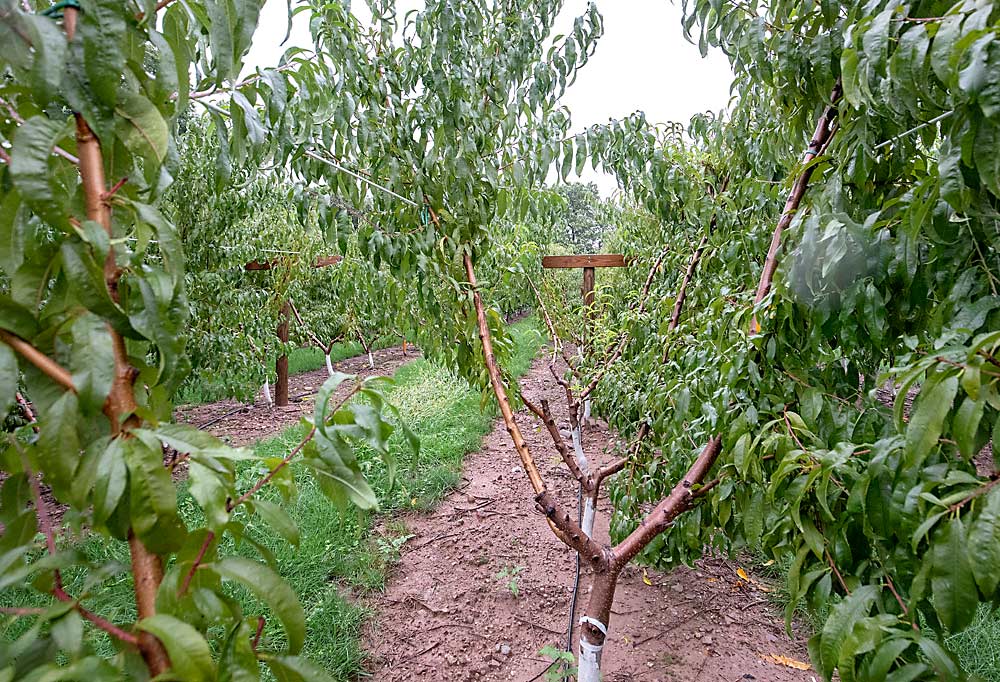
In the former block, Schupp measured the performance of the traditional open-center system against the more intensive perpendicular-V, quad-V and hex-V systems, with two, four and six leaders, respectively. All of the more intensive systems achieved higher yields per acre than the open-center system, but the highest-density system, perpendicular V, was not the most productive. Quad V and hex V, the medium-density systems (both modified perpendicular-V systems), turned out to be the most productive, he said.
Spacing has a “profound effect” on peach tree vigor, every bit as much as rootstocks, he said. The higher the density, the greater the root competition and the smaller the tree. Fruit size and yield per tree decline with increasing density, but yield per acre goes up because of the greater number of trees. Fruit size might be the “Achilles heel” of intensive peach systems, dictating how close trees can be planted, Schupp said. While a 2-foot spacing can work for apples, it’s too close for peaches.
“When we talk high-density peaches, we’re probably talking 4 to 5 feet apart within-row, and maybe 12 feet between rows,” Schupp said.
The other block Schupp showed IFTA was his NC-140 peach rootstock trial, which includes Rootpac, MP-29 and Controller rootstocks, all of which show promise for higher-density peach plantings.
“Size-controlling rootstocks for peaches has been a long-term goal of pomologists ever since I can remember,” Schupp said. “We’re finally on the cusp.”
Controller 6, 7 and 8 have proven to be productive semidwarf rootstocks, with Controller 6 the most readily available. In his trials, MP-29 and Rootpac 40 had the smallest trees with the highest crop density. Both require trellises to maintain canopy shape and productivity. Trellises require a bigger up-front investment, but trellised trees are more uniform, require less maintenance and yield earlier crops, Schupp said.
Schupp’s ideal Pennsylvania peach planting would be on Controller 8 with 5 to 6 feet between trees and 12 to 14 feet between rows. Controller 8 has a “tremendous amount of potential,” but its availability is limited, he said.
Commercial plantings
Pennsylvania peach growers also are testing rootstocks and spacings in their orchards. In connection with Schupp’s research, a dozen growers throughout the state planted rootstock trials in 2020.
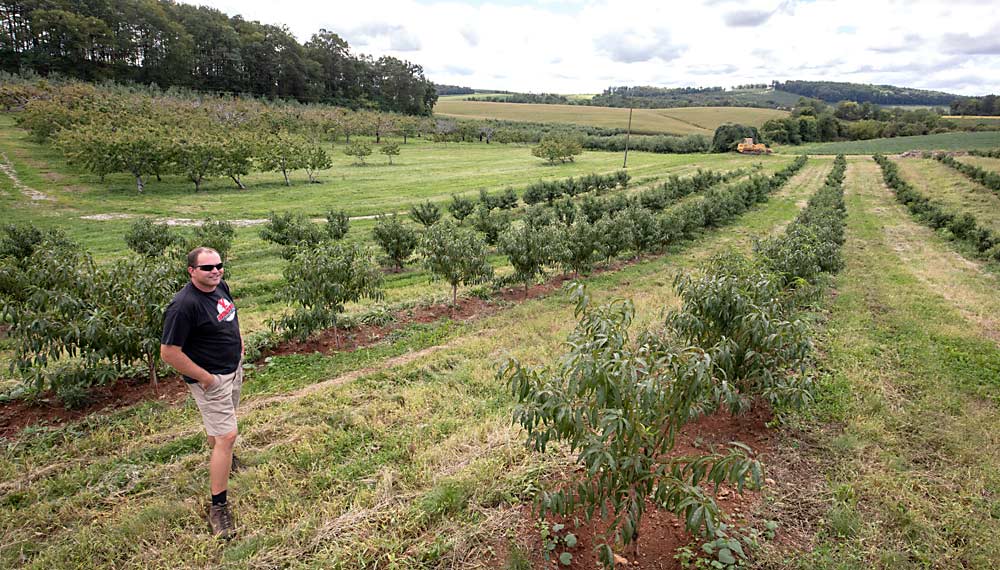
At Hilltop Orchards in Adams County, grower Brian Davis planted 1 acre of the PF Lucky 13 variety on Controller 6, 7 and 8. He spaced the trees at 8 by 16 feet, trained to quad V. His goal: to maximize the fruiting area without having to use ladders or do a lot of pruning. On his open-center trees, which are planted at 12 by 22 feet, Davis has to prune the tops every year, which limits their fruiting potential. This is the first year Davis expects a significant volume of fruit from the new planting, he said.
Greendale Orchard in Franklin County has been experimenting with different training styles and spacings for years, said orchard manager Roy Slothour.
So far, Slothour likes the quad V, and he said 8 by 18 feet might be the best spacing for fresh peaches on standard rootstocks. They’ve been trialing Controller rootstocks since 2020, with Krymsk 86 as the control. If trees on Controller roots turn out to be less vigorous, they might be able to go down to 16 feet between rows, he said.
They trellis some of their processing peaches and find that the trellised systems deliver higher yields a year or two sooner than normal and also make mechanized thinning and pruning easier. Trellising doesn’t increase fruit size, but fruit size is not as much of a concern with processing peaches, Slothour said.
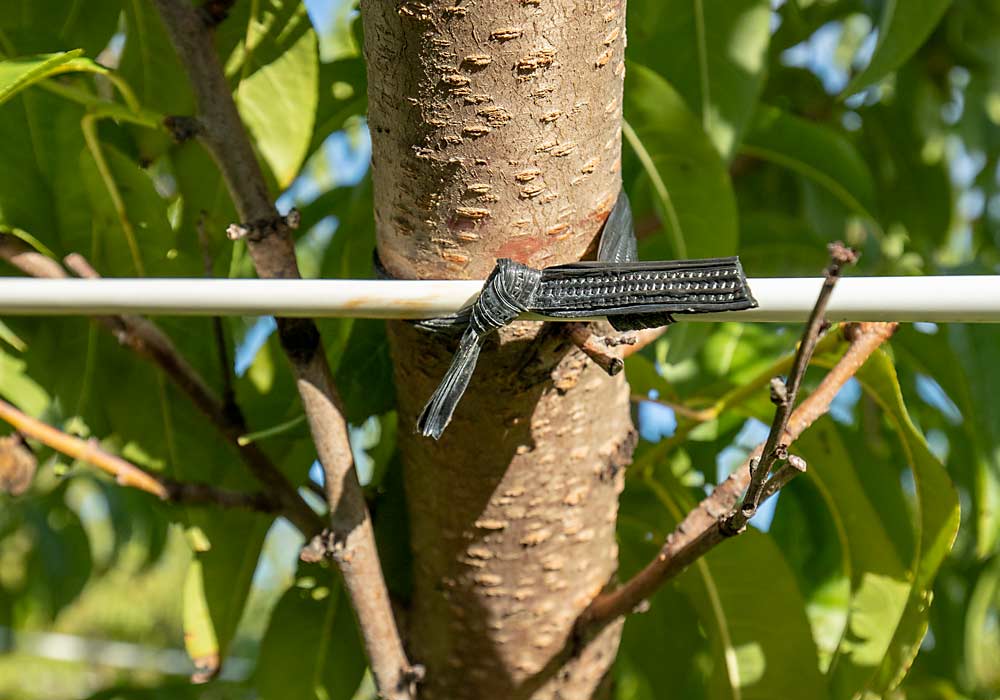
At Frecon Fruit Farms in Boyertown, northwest of Philadelphia, grower Steve Frecon planted 4 acres of high-density peaches in 2018 and another 6 acres, with trellises, two years later. Based on Schupp’s research, he chose the quad-V system over perpendicular V because of its greater productivity. He’s also trialing Controller rootstocks, he said.
Frecon’s priority isn’t so much greater production per acre as simplicity of training and maintenance. With an open-center tree, “knowing which big old wood to prune takes years of training,” he said.
But higher-density V systems can be maintained with “simple, rules-based pruning,” he said. They also lend themselves to mechanization.
In his trellised peaches, Frecon has a post every 50 feet, topped with two horizontal crossbars. He runs two Ag-Liner monofilament wires per side. Plastic wire doesn’t wound the trees as much as metal wire, lessening the possibility of bacterial canker, he said. •
—by Matt Milkovich
Watch Jim Schupp’s renewal technique:

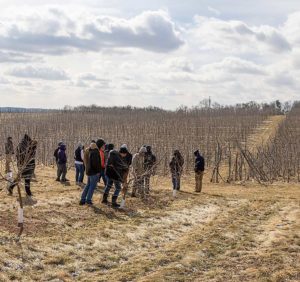
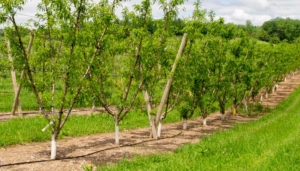
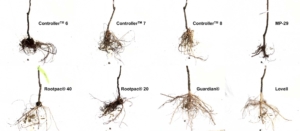





Leave A Comment